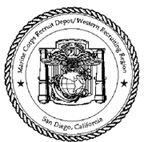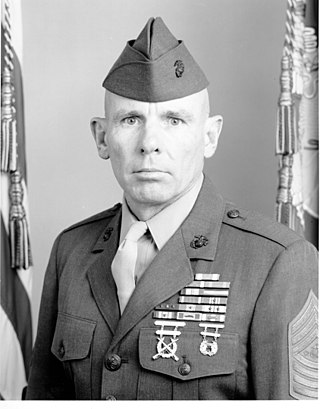
Marine Corps Base Camp Pendleton is the major West Coast base of the United States Marine Corps and is one of the largest Marine Corps bases in the United States. It is on the Southern California coast in San Diego County and is bordered by Oceanside to the south, San Clemente and Orange County to the north, Riverside County to the northeast, and Fallbrook to the east.

Military recruit training, commonly known as basic training or boot camp, refers to the initial instruction of new military personnel. It is a physically and psychologically intensive process, which resocializes its subjects for the unique demands of military employment.

Marine Corps Recruit Depot Parris Island is an 8,095-acre (32.76 km2) military installation located within Port Royal, South Carolina, approximately 5 miles (8.0 km) south of Beaufort, the community that is typically associated with the installation. MCRD Parris Island is used for United States Marine Corps Recruit Training of enlisted United States Marines. Recruits living east of the Mississippi River report there to receive initial training. Recruits living west of the Mississippi River receive training at Marine Corps Recruit Depot San Diego, California, but may train at MCRD Parris Island by special request.

A drill instructor is a non-commissioned officer in the armed forces, fire department, or police forces with specific duties that vary by country. Foot drill, military step, and marching are typically taught by drill instructors.

Marine Corps Recruit DepotSan Diego is a United States Marine Corps military installation in San Diego, California. It lies between San Diego Bay and Interstate 5, adjacent to San Diego International Airport and the former Naval Training Center San Diego. MCRD San Diego's main mission is the initial training of enlisted male and female recruits living west of the Mississippi River. Over 21,000 recruits are trained each year. As of 2022, 1.5 million recruits have completed their boot camp training at the Depot. The Depot also is the home to the Marine Corps' Recruiter School and Drill Instructors School.
The School of Infantry (SOI) is the second stage of initial military training for enlisted United States Marines after recruit training. Since the initial training pipeline is divided between coasts, Marines from areas east of the Mississippi River usually graduate from MCRD Parris Island and move on to SOI at SOI East, while those from the western half of the nation attend MCRD San Diego and move on to SOI West at the Camp San Onofre area of Camp Pendleton in California. Female Marines are trained at both SOI East and SOI West. The School of Infantry's training mission ensures "Every Marine is, first and foremost, a Rifleman". At SOI, Marines with the Military Occupational Specialty of infantry are trained at the Infantry Training Battalion (ITB), while all non-infantry Marines are trained in basic infantry and combat skills at the Marine Combat Training Battalion. SOI marks a transition in the professional training of entry-level students from basically trained Marines to combat-ready Marines.

The Basic School (TBS) is where all newly commissioned and appointed United States Marine Corps officers are taught the basics of being an "Officer of Marines". The Basic School is located at Camp Barrett in the town of Quantico in Prince William County, Virginia located in the south-west of the Marine Corps Base Quantico complex. Each year over 1,700 new officers are trained, representing such commissioning sources as the U.S. Naval Academy, Navy ROTC, Officer Candidates School, and Marine Corps Limited Duty Officer (LDO) and Warrant Officer accession programs.

Edson Range is a firing range complex at Marine Corps Base Camp Pendleton, near Oceanside, California. It is named for Marine Major General "Red Mike" Edson, "a World War II Medal of Honor recipient and a distinguished small arms marksman proponent." This rifle-qualification complex is home to four of the largest firing ranges on the base. The range became operational on August 21, 1964, the same day that Camp Calvin B. Matthews, in La Jolla, California, was closed and turned over to the University of California. Camp Matthews had previously been used for rifle training.

Lewis G. Lee is a retired United States Marine who served as the 13th Sergeant Major of the Marine Corps from 1995 to 1999. He retired from active duty in 1999 after over 31 years of service. He was the last Sergeant Major of the Marine Corps to serve in combat in the Vietnam War.

Harold G. Overstreet is a retired United States Marine who served as the 12th Sergeant Major of the Marine Corps from 1991 to 1995.

David W. Sommers is a retired United States Marine who served as the 11th Sergeant Major of the Marine Corps from 1987 to 1991.

Robert Earl Cleary was a United States Marine who served as the 10th Sergeant Major of the Marine Corps from 1983 to 1987. He served in the Marine Corps for 36 years, including seeing combat in both the Korean War and the Vietnam War. For his actions in Vietnam, he was awarded the Silver Star, the Navy Commendation Medal, and two Purple Hearts. He was the last Sergeant Major of the Marine Corps to have served in the Korean War.

Leland D. Crawford was a United States Marine who served as the 9th Sergeant Major of the Marine Corps from 1979 to 1983.

John R. Massaro is a retired United States Marine who served as the 8th Sergeant Major of the Marine Corps from 1977 to 1979.

The Series Commander is a United States Marine Corps officer assigned to a Recruit Training Company who is responsible for the conduct and instruction of Marine recruits and Marine Corps Drill Instructors within one of the two series, lead or follow. Series Commanders are typically of the rank of First Lieutenant (O-2) or Captain (O-3), and they are assisted in their duties by a Series Chief Drill Instructor or a Series Gunnery Sergeant.

United States Marine Corps Recruit Training is a 13-week program, including in & out-processing, of recruit training that each recruit must successfully complete in order to serve in the United States Marine Corps.

The 3rd Recruit Training Battalion is composed of four training companies; India, Kilo, Lima and Mike. The recruit training battalion is responsible ensuring that each company is following the procedures set forth by the Recruit Training Regiment. Each company is responsible to follow the standards established by the Commandant of the Marine Corps to train, teach, mentor, and above all lead recruits through a demanding standard-based training system. 51% of all male Marines attend recruit training at Marine Corps Recruit Depot, San Diego, California.
The 1st Recruit Training Battalion is a battalion of the United States Marine Corps which is used to train new enlisted personnel. It is composed of four Training Companies; Alpha, Bravo, Charlie, and Delta. The recruit training battalion is responsible for ensuring that each company is following the procedures set forth by the Recruit Training Regiment. Each company is responsible to follow the standards established by the Commandant of the Marine Corps to train, teach, mentor, and above all lead recruits through a demanding standard-based training system. 51 percent of all male Marines attend recruit training at Marine Corps Recruit Depot San Diego (MCRDSD), California."

John Thaddeus Walker was a highly decorated officer of the United States Marine Corps, who reached the rank of lieutenant general. He is most noted as commanding officer of the 22nd Marine Regiment during Battle of Eniwetok. He later served as director of personnel or commanding general of the Marine Corps Recruit Depot San Diego.



















